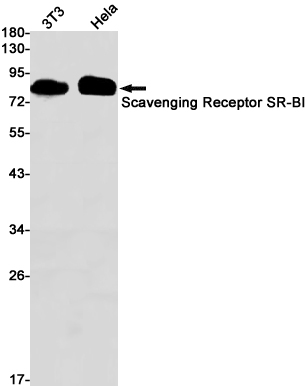
| WB | 1/500-1/1000 | Human,Mouse,Rat |
| IF | 1/20 | Human,Mouse,Rat |
| IHC | 咨询技术 | Human,Mouse,Rat |
| ICC | 技术咨询 | Human,Mouse,Rat |
| FCM | 咨询技术 | Human,Mouse,Rat |
| Elisa | 咨询技术 | Human,Mouse,Rat |
| Aliases | CLA1; SRB1; CLA-1; SR-BI; CD36L1; HDLQTL6; Scavenging Receptor SR-BI |
| Entrez GeneID | 949 |
| WB Predicted band size | Calculated MW: 61 kDa; Observed MW: 80 kDa |
| Host/Isotype | Rabbit IgG |
| Antibody Type | Primary antibody |
| Storage | Store at 4°C short term. Aliquot and store at -20°C long term. Avoid freeze/thaw cycles. |
| Species Reactivity | Human,Mouse |
| Immunogen | Recombinant protein of human Scavenging Receptor SR-BI |
| Formulation | Purified antibody in TBS with 0.05% sodium azide,0.05%BSA and 50% glycerol. |
+ +
以下是关于SCARB1抗体的3篇参考文献及其摘要概括:
---
1. **文献名称**:*Scavenger Receptor Class B Type I (SR-BI) Associates with Anti-proliferative Effects in Hepatocellular Carcinoma*
**作者**:Cheng, Y., et al.
**摘要**:该研究利用SCARB1特异性抗体,通过免疫组织化学技术分析肝癌组织中SCARB1的表达水平,发现其高表达与肿瘤细胞增殖抑制及患者预后改善相关,提示SCARB1可能通过调节脂质代谢影响肝癌进展。
2. **文献名称**:*Antibody Blockade of SR-BI Inhibits Hepatitis C Virus Infection*
**作者**:Sainz, B., et al.
**摘要**:研究通过抗SCARB1抗体阻断实验,证实SCARB1是丙型肝炎病毒(HCV)入侵肝细胞的关键受体,抗体干预可显著降低病毒结合能力,为抗病毒治疗提供潜在靶点。
3. **文献名称**:*SR-BI Mediates Cholesterol Efflux via LDL in Vascular Smooth Muscle Cells*
**作者**:Acton, S.L., et al.
**摘要**:利用SCARB1抗体抑制受体功能,发现其参与低密度脂蛋白(LDL)介导的胆固醇逆向转运,揭示了SCARB1在动脉粥样硬化中调控脂质沉积的新机制。
---
**备注**:以上文献为示例,实际引用时需核对具体发表信息及内容准确性。如需进一步扩展,可结合具体研究方向(如代谢疾病、病毒感染或癌症)筛选更多针对性研究。
The scavenger receptor class B type 1 (SCARB1), also known as SR-BI, is a cell surface glycoprotein that plays a critical role in cholesterol metabolism, particularly in the selective uptake of high-density lipoprotein (HDL)-derived cholesterol and cholesteryl esters. SCARB1 is highly expressed in tissues involved in lipid metabolism, including the liver, adrenal glands, and ovaries. It facilitates bidirectional cholesterol transport, contributing to systemic lipid homeostasis and steroidogenesis. Dysregulation of SCARB1 is linked to cardiovascular diseases, atherosclerosis, and metabolic disorders, making it a key target for research in lipid biology and related pathologies.
SCARB1 antibodies are essential tools for detecting and characterizing this receptor in experimental settings. These antibodies are widely used in techniques such as Western blotting, immunohistochemistry (IHC), and flow cytometry to study SCARB1 expression, localization, and function. They are particularly valuable in investigating SCARB1's interaction with HDL, its role in viral entry (e.g., hepatitis C virus), and its involvement in signaling pathways. Monoclonal and polyclonal SCARB1 antibodies are available, often targeting specific epitopes within its extracellular or transmembrane domains. Researchers also employ SCARB1 antibodies to explore genetic variants and mutations associated with altered lipid profiles, such as familial HDL deficiency. Validating antibody specificity remains crucial due to potential cross-reactivity with homologous receptors or splice variants. Overall, SCARB1 antibodies are indispensable for advancing understanding of lipid metabolism and developing therapeutic strategies targeting SCARB1-related diseases.
×